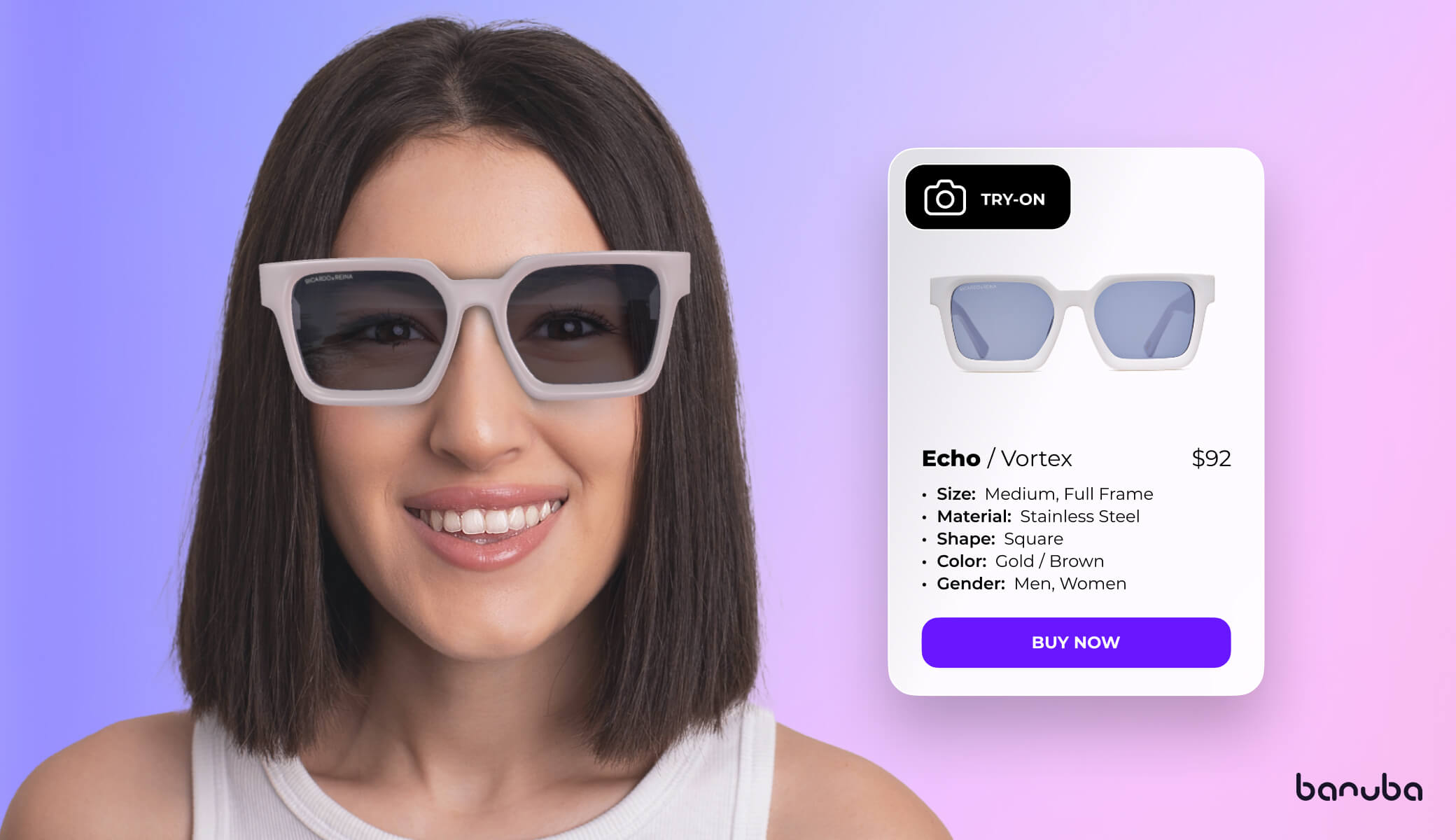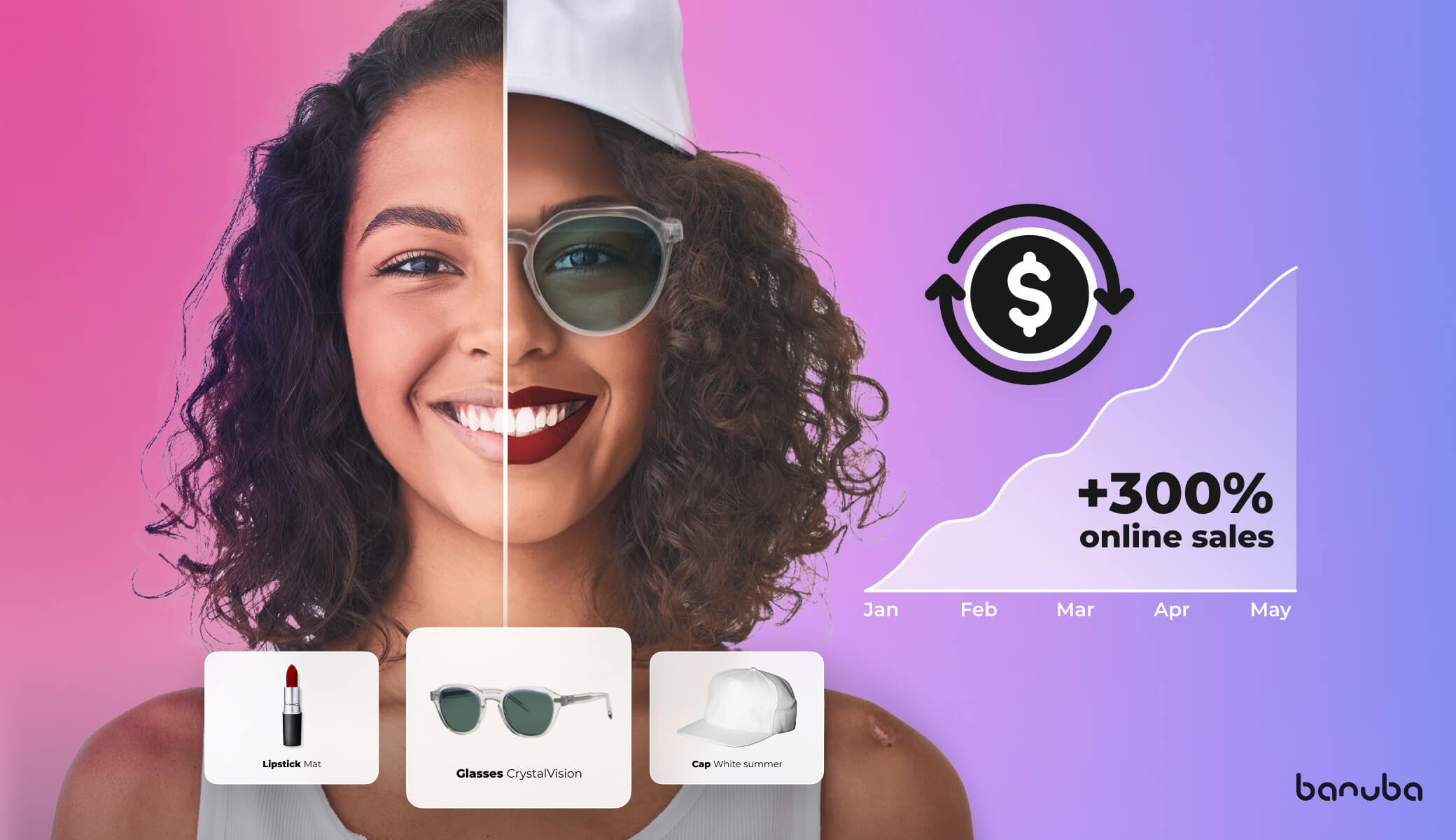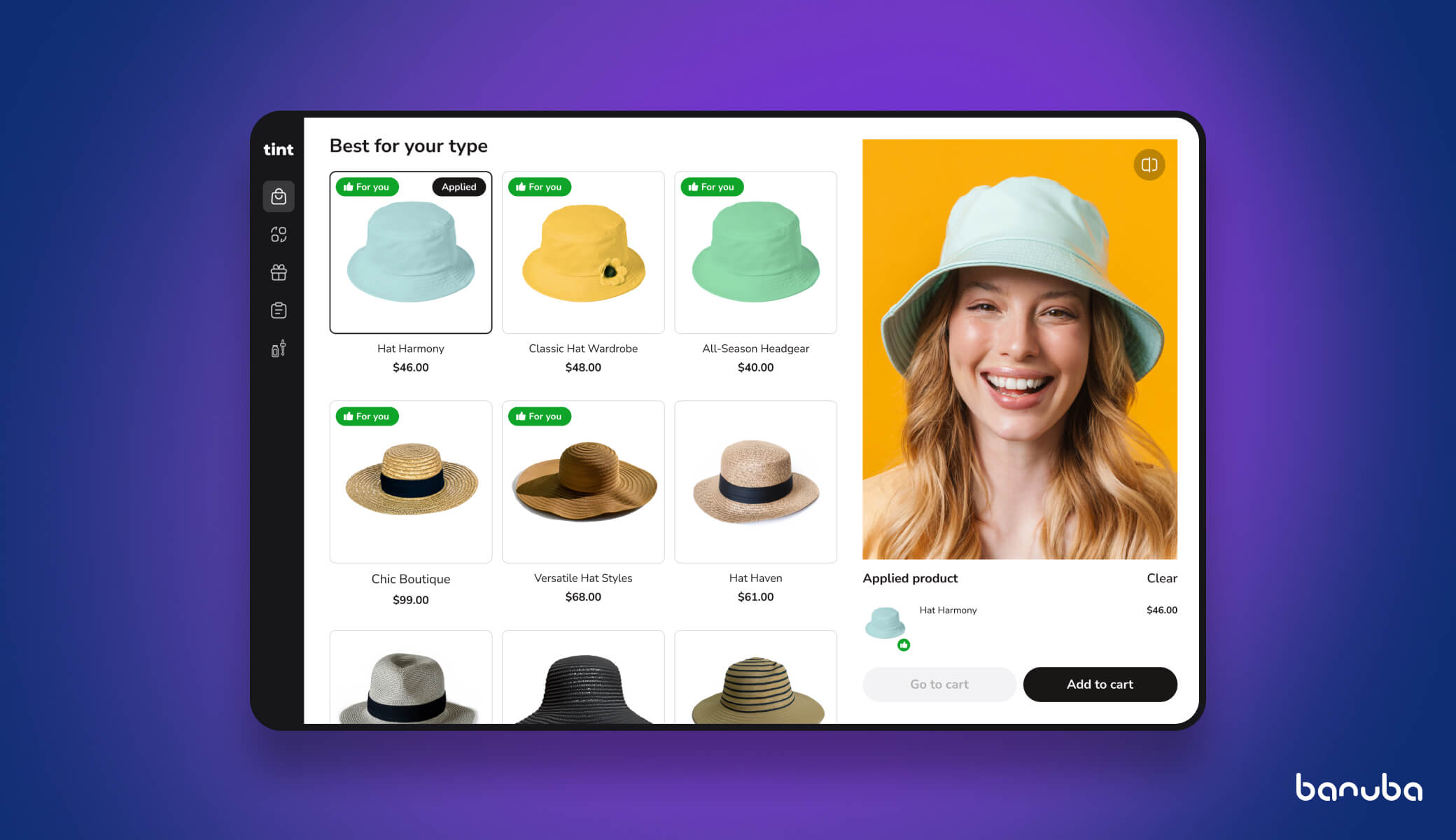TOP 8 Virtual Glasses Try-On Apps

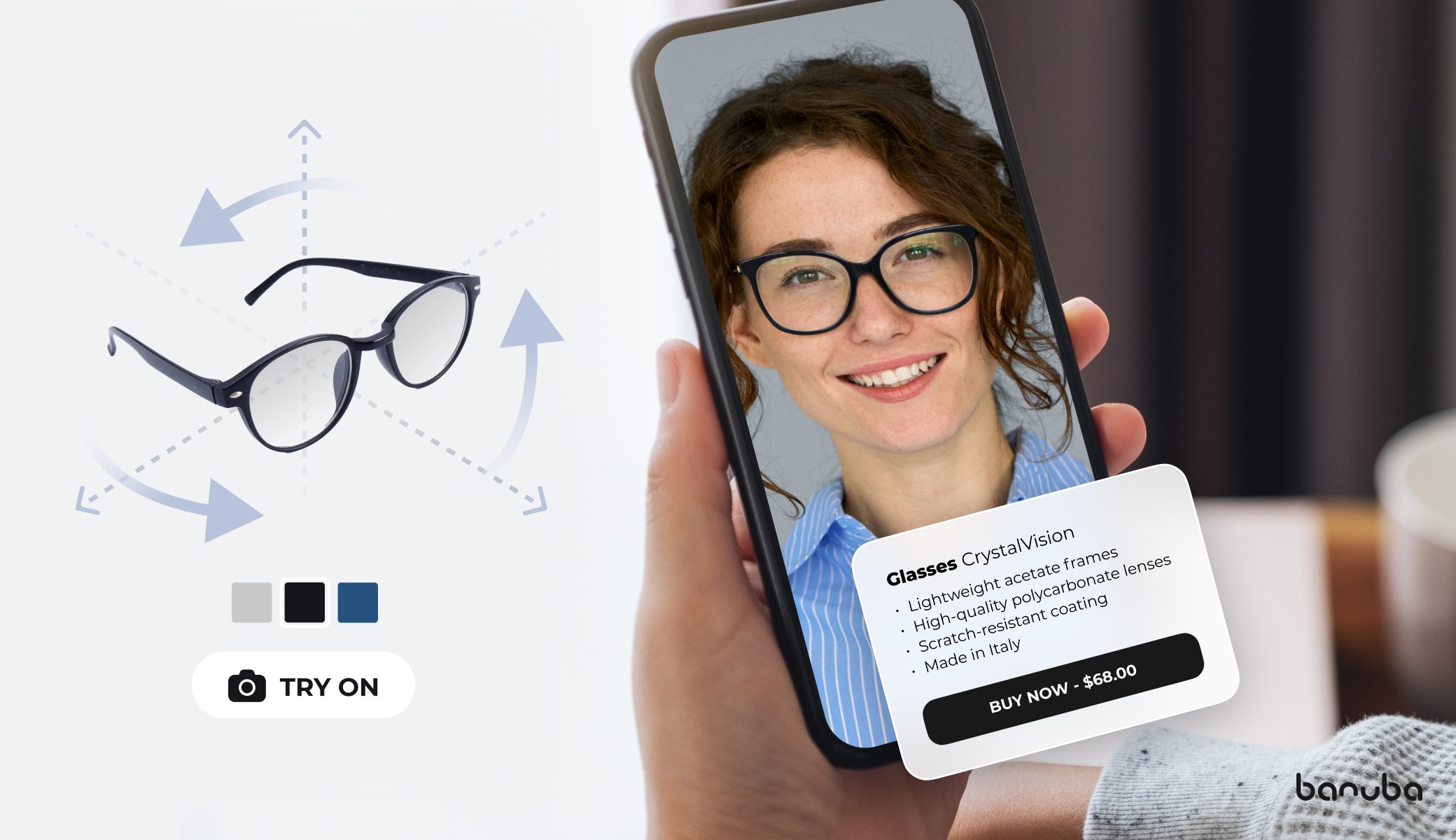
[navigation]
TL;DR
- A virtual try-on glasses app uses AR technology to help users visualize products on them.
- AI recommendation systems analyze user input (face shape, eye position, style preference etc.) and extract features from the user's characteristics to match suitable frames to the user's face
- The benefits of using virtual try-on for glasses include:
- Enhanced customer experience
- Increased confidence in purchase decisions
- Convenience and accessibility
- Cost- and time-efficiency
- Decreased return rate, and more.
- To choose the best virtual glasses try-on app for your business, define your requirements, research reputable providers and evaluate their app's user experience, compatibility, and integration capabilities. Look for customization options and scalability, like those offered by Banuba's TINT, which ensures fast integration and ongoing support.
What Is A Virtual Try-On Glasses App?
A virtual try-on glasses app is a mobile application that utilizes augmented reality (AR) technology to allow users to virtually try on glasses frames using their smartphone or tablet. Basically, you can now try on pair eyewear options virtually before making a purchase.
These apps typically use the device's camera to superimpose AR frames onto the user's face instantaneously or through uploaded photos. People can then see how different styles, colors, and shapes of glasses look on their faces without physically trying them on. We have created a whole virtual try-on guide for you to know more about how it works, so make sure to check it out.
Virtual glasses apps often include features such as:
- Frame Selection. Consumers can browse through a wide variety of frames available within the app's catalog.
- Real-time Visualization. The app overlays the selected glasses onto the user's face using the device's camera.
- Photo Upload. Users can upload a picture of themselves to see how glasses frames will look on their faces without using the device's camera.
- Virtual Mirror. Some apps offer a virtual mirror feature that allows consumers to move their heads and see how the glasses look from different angles.
- Sharing Options. Users can share their virtual try-on experiences with friends and family through social media or messaging platforms.
- Shopping Integration. Many virtual try-on glasses apps are integrated with e-commerce platforms, allowing users to seamlessly buy the eyewear they like directly from the app.

Which Glasses Suit Me Best? or Behind the Recommendations system
How does the app match virtual glasses with the face shape, offering a selection of multiple pairs? The recommendation in digital try-on for eyewear works through a combination of machine learning algorithms, computer vision technology, and user data analysis. Here's how it typically works:
User Input. The process begins with the user providing some initial input, such as their face shape, style preferences, and any specific requirements they may have for their glasses. Let's say they like oval frames for their heart-shaped face and only stick to them.
Data Collection. The platform may collect additional data from the user, such as their past buying history, browsing behavior, and feedback on previous online try-on sessions.
Algorithm Training. Machine learning algorithms are trained using a large dataset of glasses frames and corresponding user preferences. These algorithms analyze various factors such as frame shape, color, material, and brand popularity to identify patterns and correlations.
Feature Extraction. Computer vision technology is used to extract features from the user's facial structure and characteristics, such as face shape, eye position, and distance between facial landmarks.
Matching Algorithm. The recommendation system uses the user's input, data collected, and feature extraction to match suitable frames to the user's face. This matching process considers factors such as size, shape, and style compatibility with the user's facial features and preferences. As a result, they receive the best glasses to suit their face shape and taste.
Feedback Loop. As users interact with the online try-on platform and provide feedback on recommended frames (e.g., liking or disliking certain styles), the recommendation system continuously learns and adapts to improve future recommendations.
Integration with E-commerce. Once suitable glasses frames are recommended, the user can seamlessly transition to the e-commerce aspect of the platform to view more details about the recommended frames, such as pricing, availability, and customer reviews, and buy it if desired.
Benefits of Virtual Try-On for Glasses in E-Commerce
The favorite glasses suit customers until they fall in love with another perfect pair that highlights their oval or square faces better than the old one. But how to persuade a client to buy new glasses, not typical for their taste? That's when the try-on glasses virtually step into the game, demonstrating its obvious benefits both for the retailer and the buyer.
Enhanced Customer Experience
Virtual try-on glasses apps provide customers with a more interactive and engaging experience, allowing them to visualize how different glasses frames will look on their face before making a purchase. Besides, the recommendation algorithm in some VTOs can help customers explore new styles and find glasses that they have never expected to suit their round or heart-shaped face.
Increased Confidence in Purchase Decisions
By seeing themselves wearing the glasses virtually, customers gain more confidence in their decisions, reducing the likelihood of returns due to dissatisfaction. As much as 71% of buyers confessed they would shop more if AR was available in-store.
Convenience
Customers can try on sunglasses virtual copies from the comfort of their own homes, eliminating the need to visit a physical store. This convenience can lead to higher conversion rates and customer satisfaction.
Wider Product Reach
Digital try-on technology enables customers to explore a wider range of glasses styles and brands than they might find in a traditional store, expanding their options and potentially increasing sales for e-commerce platforms. Besides, a recommendation engine can upsell by offering to try on glasses based on individual taste and data-based insights. The engagement with AR leads to conversion rates growing by 90%.
Personalization
The digital try-on can be integrated with recommendation algorithms to suggest glasses frames that best match the customer's face shape, frame styles preferences, and previous purchases, creating a more personalized experience. And almost 50% of consumers would rather buy from a web retailer offering a personalized approach.
Time and Cost Savings
Customers save time and money by avoiding the need to travel to a physical store to try on glasses. Additionally, e-commerce platforms can save on overhead costs associated with maintaining physical retail locations.
Reduced Product Returns
The technology helps decrease the risk of returns by allowing customers to preview how glasses will look on them before purchasing. This leads to fewer returns due to misaligned expectations regarding style or fit.
Accessible for All
Virtual try-on technology can accommodate customers with disabilities or specific needs, such as those requiring adaptive technology for vision impairments, ensuring inclusivity in the shopping experience.
Social Sharing and Feedback
Customers can share virtual try-on images with friends and family for feedback, fostering social engagement and potentially driving referral traffic to the e-commerce platform.
Data Insights
E-commerce platforms can gather valuable data on customer preferences and behavior through virtual try-on interactions, enabling them to refine product offerings, marketing strategies, and user experience over time.
The Best Apps to Try On Glasses Online
Virtual glasses try-on can help a store create an extra and fun customer touchpoint and guide them to the perfect pair. Let's explore VPOs and virtual try-on glasses apps that have already successfully helped customers find the best glasses virtually.
Banuba Glasses and Contact Lenses Virtual Try-On
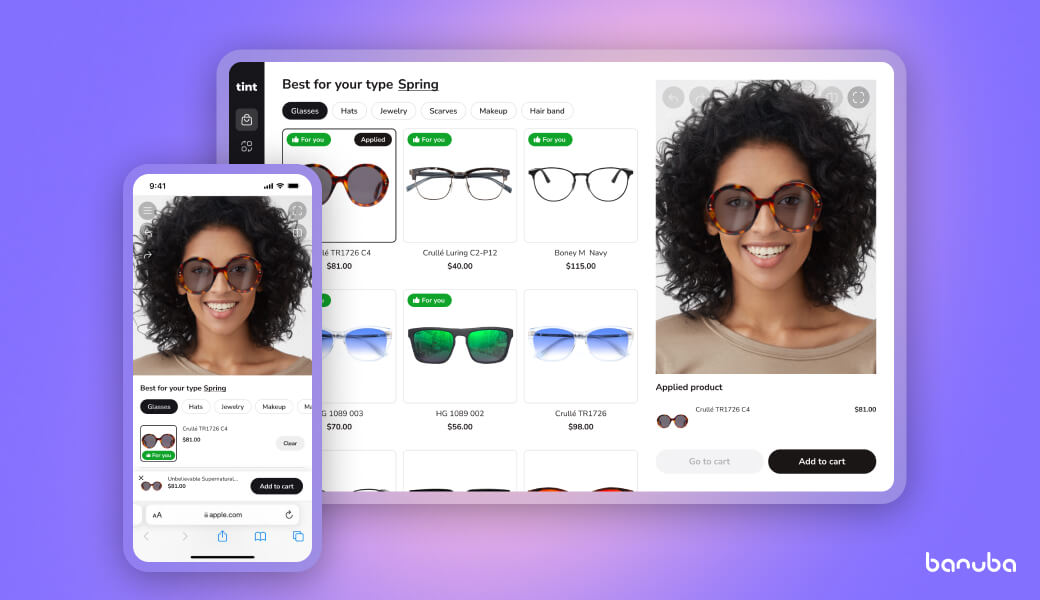
Banuba offers a full-scope virtual glasses SDK available on Android and iPhone mobile devices, web, and desktop. Offering precise item fitting, lifelike product appearances, and a seamless try-before-you-buy experience, the SDK ensures your customers keep coming back for the best glasses to complement their face shape with different styles.
The cutting-edge face tracking algorithm places virtual glasses naturally, taking into account face shape - round, square, oval, or heart-shaped - and lips, nose, eyes, and even hair, making it one of the best virtual glasses try-on solutions on the market. The app can also work on low-end devices, enhancing the low resolution of the camera to ensure a true-to-life and dynamic image. Intuitive product selection and checkout process within the interface streamline the purchasing journey for your customers.
In addition to sunglasses, consumers can virtually try on lenses to experiment with styles. The algorithm detects and ensures precise placement on the desired eye area — sclera, iris, or the full eye.
You can try on glasses and lenses during the free trial or check the interface and functionality in your browser.
Warby Parker
Warby Parker is a bright example of how retailers can implement a virtual glasses app into their sales funnel and customer experience. The brand's free app is available on Android and iOS, with pupillary distance measurements available only on the latter. Consumers need to download the app to try on glasses, restock their lenses by scanning the box, and save their favorite styles.

Ideofit — Glasses and Sunglasses
This virtual glasses app helps consumers experiment with styles by creating an account either on Android or iPhone. It grants access to a directory with over 100 frames to match square faces or round ones. Consumers can virtually adjust the placement to their common wearing style — lower on the nose or higher. Having decided on the best glasses, they can download the image or share it with mates on social media. Besides, the app redirects to the sunglasses page on Amazon. Note that the app costs $1.

VirTry
VirTry is another free iOS app for trying-on eye accessories virtually. It allows applying the AR overlay at present or on a photo from the camera feed. Acting like. asmart mirror, it allows exploring the pair from different angles. Having chosen the best glasses for the face shape, consumers can save their favorite styles in their account to compare.

MisterSpex
MistexSpex leverages virtual glasses to help its customers find that perfect pair. The app is web-based and free. Clients must record a video following the instructions to create footage from different angles to ensure that the glasses suit them well. The video is then cached on the website, automatically overlaying a pair on the animated photo on every product page.

Zenni Optical
This retailer uses virtual glasses via recording a 5-second-long footage. The credit card pressed on the forehead acts like a scale to help choose the best-matching size. The face shape tool will offer to try on glasses taking into account the user's characteristics — round or square — to complement the look. Sharing and download options are also available.

GlassOn
GlassOn is a digital try-on glasses solution for retailers with 3D modeling available. They position themselves as an affordable app with easy integration. Business owners are also encouraged to create an avatar using AI to replace human models to demonstrate various accessories.

FittingBox

This virtual sunglasses try-on platform integrates with the majority of well-known e-commerce sites, including Shopify. The app has a database with frames, among which you will find the best glasses for every face shape.
How to Choose an App for Virtual Glasses Try On for Your Business?
Choosing an app for virtual glasses try-on for your business requires careful consideration of several factors to ensure it aligns with your specific needs and goals. Here's a step-by-step guide to help you choose the right app.
Define Your Requirements
Start by clearly defining your business requirements and objectives. Consider factors such as the target audience, desired features, price, integration with existing systems, and scalability. Decide at what stage of the sales funnel will the app be involved.
Research Available Options
Conduct thorough research to identify available virtual try-on apps for glasses. Look for reputable providers with a proven track record in the industry. Consider factors such as the app's features, user interface, customization options, compatibility with different devices, and customer support.
Evaluate Features
Evaluate the components offered by each app and compare them against your requirements. Key features to consider include real-time virtual try-on, photo upload, and download functionality, extensive glasses frame catalog, customization options, integration with e-commerce platforms, analytics, and reporting capabilities, and social sharing features.
User Experience
Pay attention to the user experience provided by each app. Choose an app with an intuitive and user-friendly interface that offers a seamless and engaging virtual try-on experience for your customers.
Compatibility and Integration
Ensure that the app is compatible with various devices and operating systems, including smartphones, tablets, and web browsers. Additionally, consider whether the app integrates seamlessly with your existing e-commerce platform or requires additional customization.
Banuba's VTO offers a fast integration with a lifetime support and maintenance, providing free software updates. In addition to laptops, smartphones and tablets, Banuba's solution can be installed in-store as a smart mirror, offering more engagement.
Customization Options
Look for an app that offers customization options to align with your brand identity and business requirements. This may include customizing the app's interface, branding, and user experience to reflect your brand's aesthetics and values.
Scalability and Flexibility
Choose an app that is scalable and flexible to accommodate future growth and changes in your business requirements. Consider whether the app can easily scale to support increased traffic and transactions as your business expands.
Trial and Demo
Before making a final decision, consider requesting a trial or demo of the app to test its functionality and performance firsthand. This will allow you to evaluate whether the app meets your expectations and requirements before committing to it. With Banuba, you can test the solution without extra help at any time or schedule a demo to discuss customization and integration with an expert.
Customer Support and Maintenance
Finally, consider the level of customer support and maintenance offered by the app provider. Choose a provider that offers responsive customer support, regular updates, and ongoing maintenance to ensure the smooth operation of the app and address any issues or concerns that may arise.
With only 1% or retailers leveraging the AR in the processes, you have every chance to gain a solid market share with a superior competitive advantage in the form of a personalized customer journey with maximum engagement. Just stick to a reliable tech partner to cover your back.



